Hunting black trumpets (Craterellus fallax) is often a wild, woodsy adventure; they are one of the most elusive mushrooms to forage. Black trumpets are small dark horn-shaped mushrooms that blend right in with the forest floor. But, there is a big reason we all go out there looking year after year for this tricky mushroom – they're delicious!
With a taste unlike any other mushroom, black trumpets are absolutely worth the effort, possible heartbreak, and certain frustration. Don't be deterred, though! Black trumpets grow in the same location year after year, so once you find a patch, you'll be able to enjoy these treasures for many years.
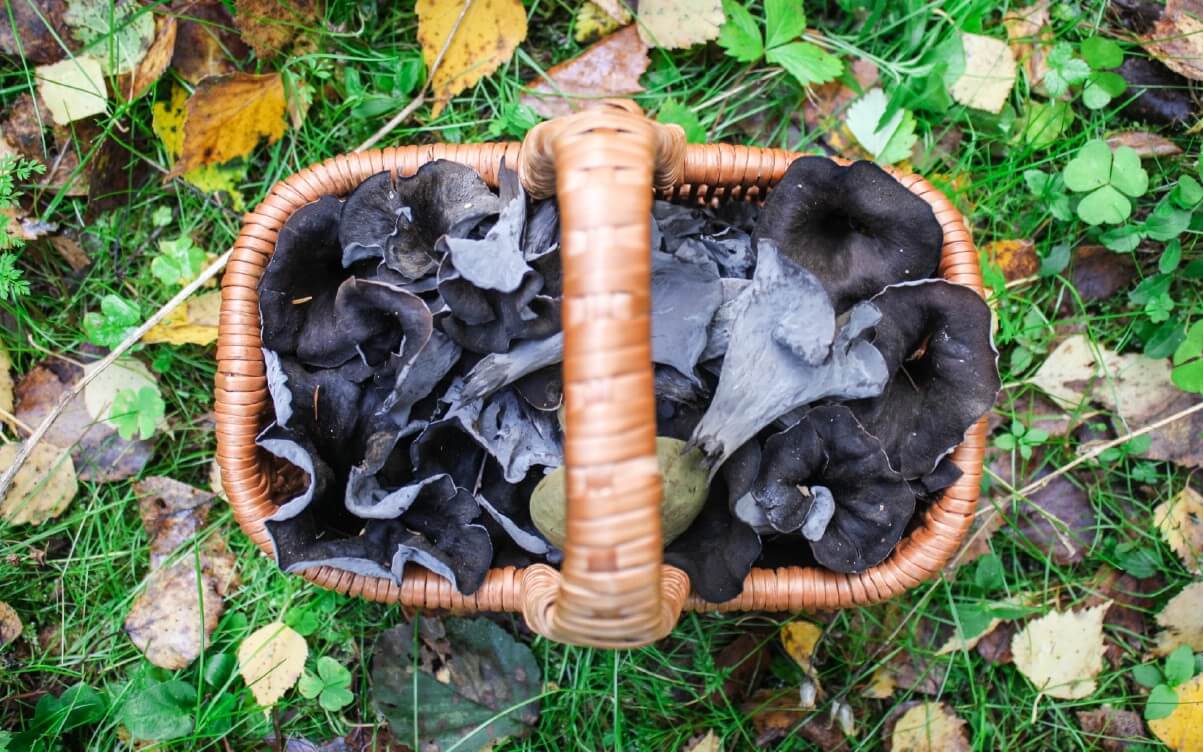
Jump to:
What Is The Black Trumpet?
You may be more familiar with black trumpet mushrooms by another name. The yare also commonly known as the Horn of Plenty, Trumpet of the Dead, or Black Chanterelle, black trumpets look like little black funnels.
The French call it trompette de la mort or trumpet of the dead, as do the Italians, trombetta dei morti. No one is sure of the exact origin of this morbid name, but many theorize it's because the mushrooms look like trumpets being played by dead people from underground.
Or, maybe it's because you'll wear yourself to death looking for them! Whatever the case may be, don't let the name scare you off. Eating black trumpets won't kill you; in fact, they make your culinary life a whole lot more interesting.
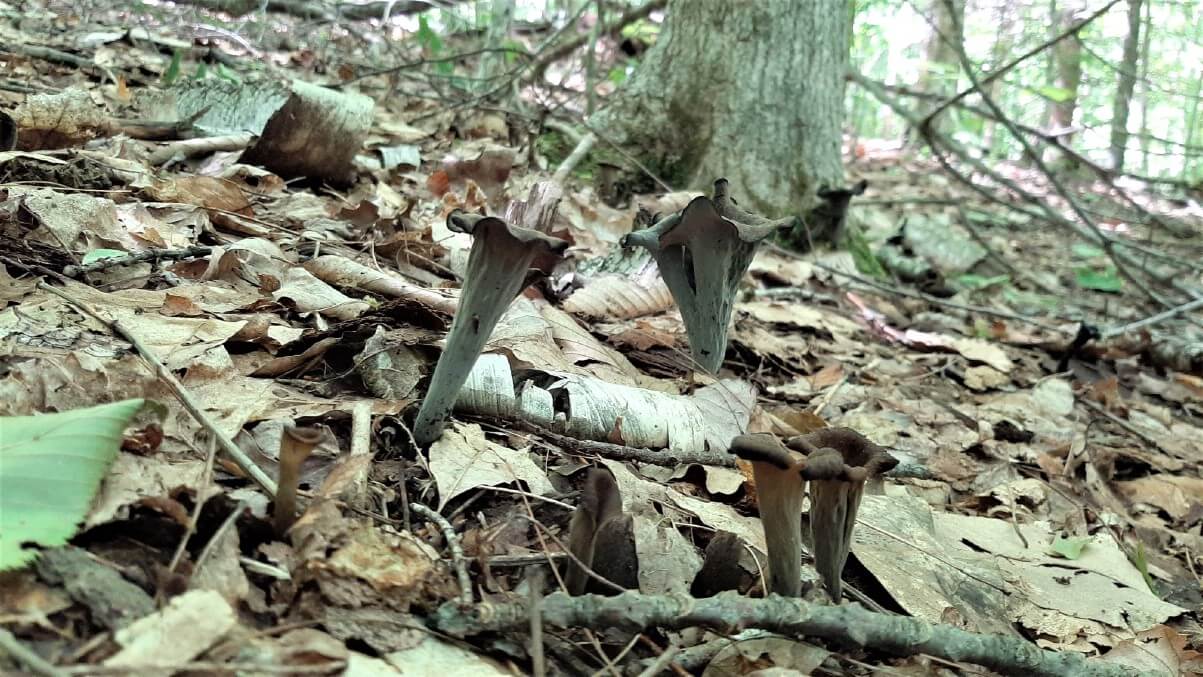
A side note: In North America, the eastern black trumpet is Craterellus fallax. The western black trumpet is still commonly called Craterellus cornocopioides, but it is almost certainly a separate species. C.cornocopioides is the European black trumpet and likely only grows in Europe. The jury is still out, though, as to the specifics of each species.
Why Are Black Trumpets So Special?
The black trumpet mushroom is only found in the wild; it has eluded commercial cultivation so far. In addition to this, it can be pretty challenging to find and, during drought years, won't show up at all. These factors combined make the black trumpet a somewhat rare and special mushroom species.
Black trumpets also have a unique taste. They're earthy, aromatic, and smoky in flavor, yet delicate and wispy in composition. It's an odd, rather exotic look and taste and one that shouldn't be missed.
All in all, a good forage and find of black trumpets is something to celebrate!
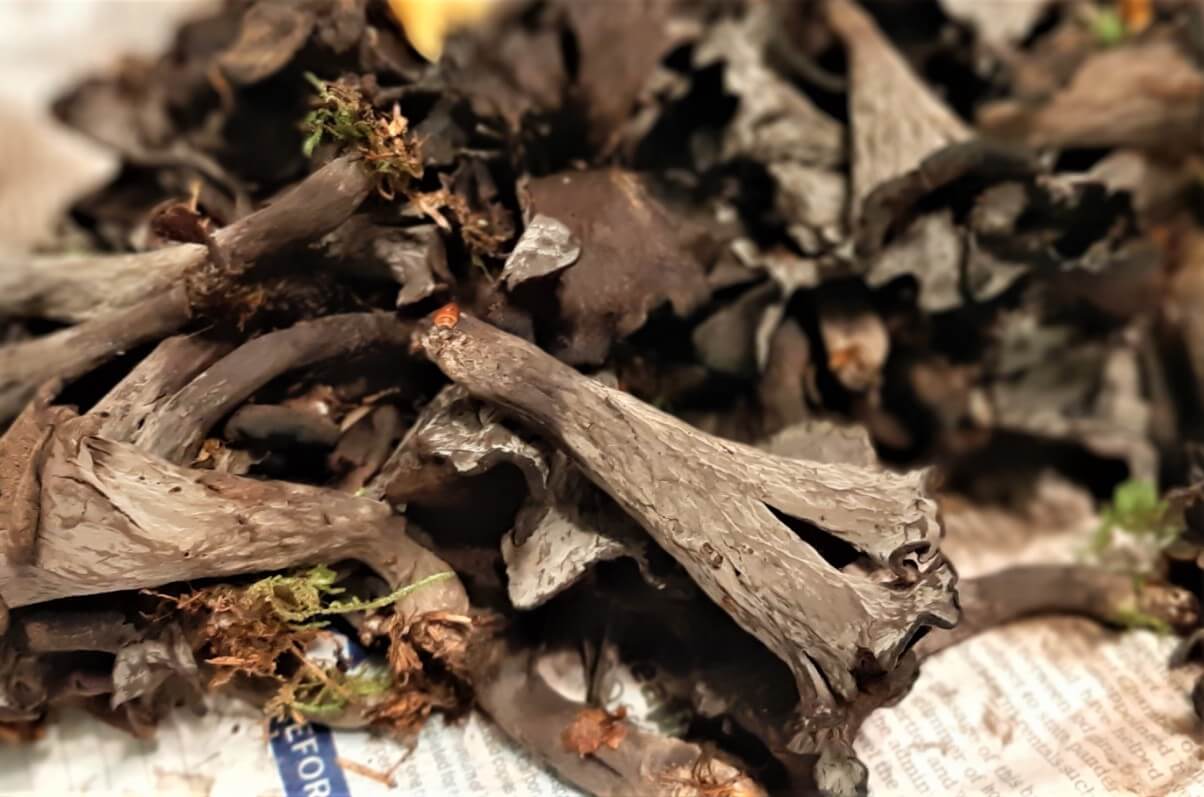
Black Trumpet Foraging Season
On the east coast, black trumpet season ranges from mid-July through late August. Sometimes it starts earlier, or goes longer, depending on the weather and rains. During extremely dry years, they won't appear until late summer, or not at all. Black trumpets are a little finicky and will only grow when they feel the conditions are right.
West coast black trumpets are winter mushrooms, starting in November and going through March. They prefer the cooler temperatures of winter.
Throughout the foraging seasons, on both coasts, black trumpets will appear in spurts as the weather suits them. It is common for microclimates to play a prominent role in their growth. We've seen several weeks of separate first fruitings in known black trumpet patches for no apparent reason other than they just weren't ready yet. Separated by 30 miles, the trumpets were doing their own thing on their own time.

One thing that will significantly improve your chances of successfully finding black trumpets is hitting the woods at the right time. Find some local foragers, or join some local online mushroom groups. When the first black trumpets appear, you'll know because everyone will be talking about them. This will at least get you out in the woods at the correct time. Then, you'll have to rely on your eyesight and perseverance.
How To Identify Black Trumpets
Study the pictures closely, so you know exactly what to look for while out in the woods. These culinary gems are masters at hiding, but if you know what you're looking for, you'll do much better at finding them.
Black Trumpet Description
These delightful little mushrooms are black to light gray, often featuring soft gray exteriors and deep black interiors. Black trumpets are vase or trumpet-shaped and smooth without any gills. They grow 1-4 inches tall, thin, and skinny. There is no obvious cap or stem, as you'd see with most other mushrooms.
Black trumpet flesh is very thin and breaks easily, so be sure to handle them gently. Handle with care! And transport home with care, too.
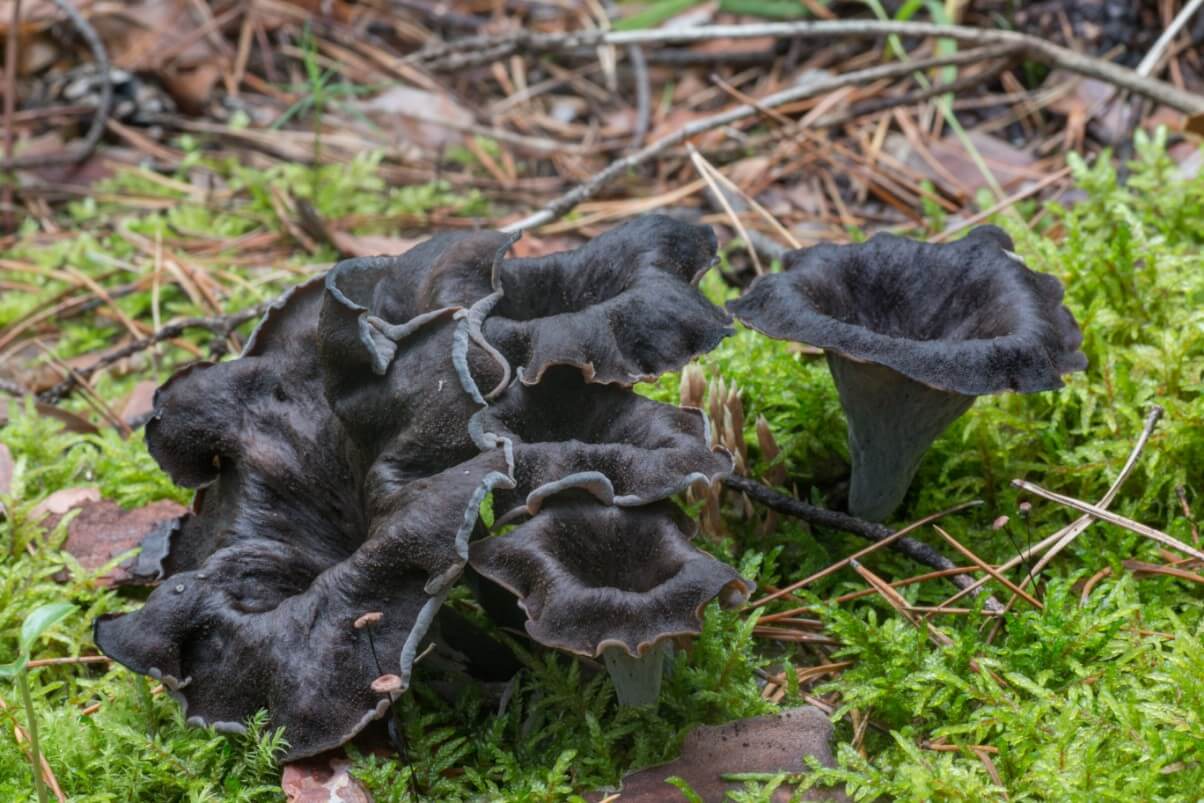
Habitat
Black trumpets grow out of the ground. They never grow on trees, stumps, or wood. They're often found growing on mossy forest floors, but they're also known to grow in sandy areas along coasts.
Black trumpets fruit in patches, in mycorrhizal association with trees. This means they have a symbiotic relationship with the trees and most likely depend on each other to survive. Or, at least the black trumpets rely on the trees to live.
The east coast black trumpet, C.fallax, grows specifically with oaks. These black trumpets have been found with other hardwoods, but they most often associate with oak trees. On the other hand, western black trumpets grow in association with conifers and hardwoods. From Douglas fir to madrone to coast live oak, they are much more flexible in their growth preferences.
Growth Habit
The black trumpet mushroom grows singularly in large groupings. When you find one, you'll certainly find many others nearby. Sometimes, they fruit in close clumps of two or three, but most often, they'll be singular upshoots from the ground.
The takeaway here is, if you find one, keep looking--you're bound to find more.
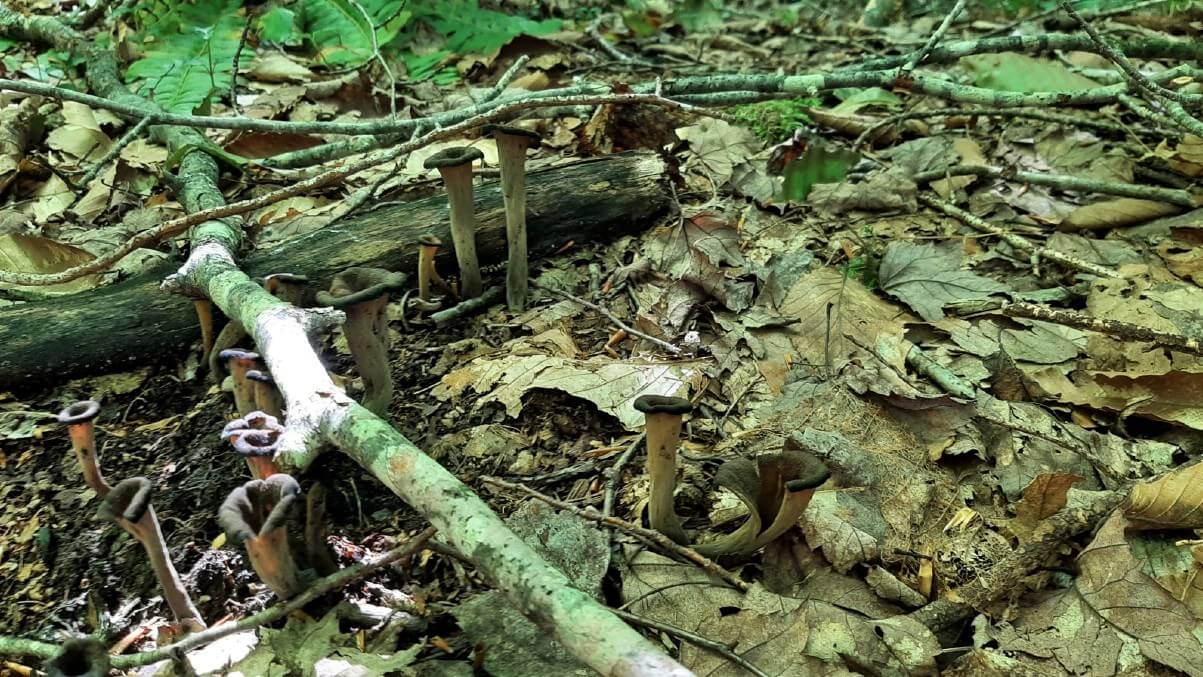
How To Find Black Trumpets
As you can see from the descriptions, these mushrooms are small, dark-colored, and appear when and where they want to. There are some things you can do to increase your chances of finding them, though. And once you do see them, mark that spot on a map or your GPS, and don't lose it! Trumpets reappear year after year in the same location. So, once you've found a couple of patches, you'll be set for years.
Since black trumpets grow in association with specific trees, seek out these trees during the prime foraging season. On the east coast, concentrate your searches to oak stands; start your search around conifers on the west coast. This will at least narrow down the search field a little bit.
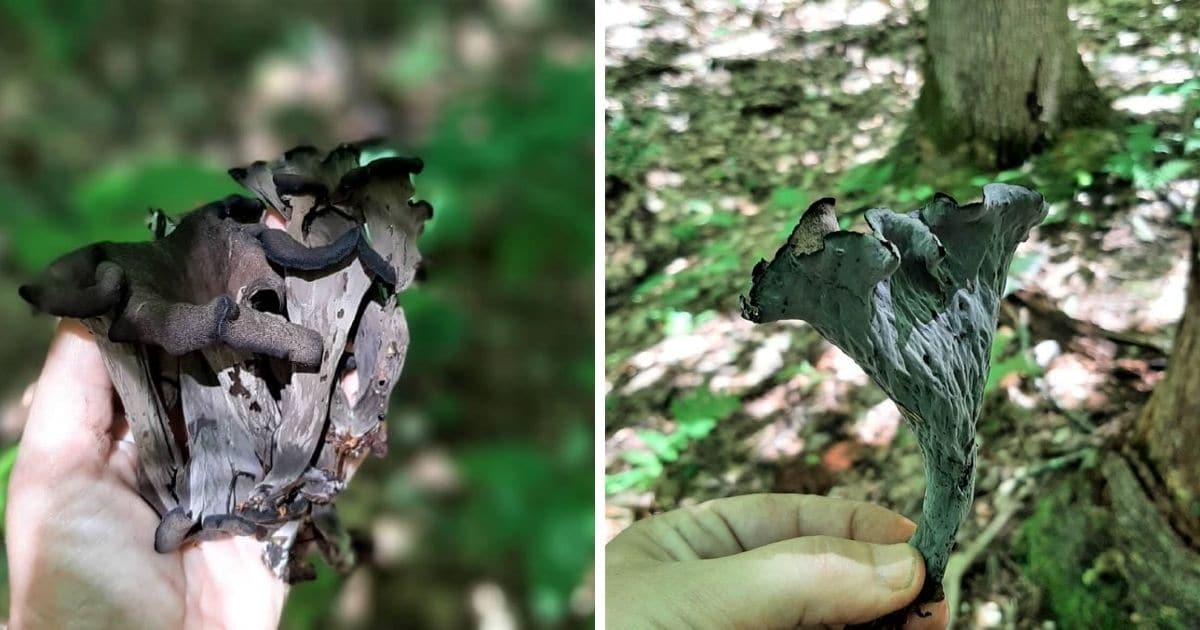
Black trumpets like moist, mossy conditions and are often found around streams or creeks. This elusive mushroom prefers darker, shaded forest locations; rarely will you find them growing in full sun. If you find some nice shaded, mossy areas with plentiful oak trees, that's an excellent place to start. Following small creeks and looking along the banks is another often successful tactic.
They only appear after significant amounts of rain, so pay attention to the weather. But, also, be patient. These mushrooms are slow growers – it may take them 6-14 days to appear after the rains.
Always keep your eyes on the ground and look closely. Black trumpets will sneak right up on you, or you'll walk right past them; that's how easily they blend. But, if you're scanning the ground in mossy, shaded areas during peak season, they may be right there waiting for you. It will take time to get the hang of foraging for black trumpets since they naturally camouflage with the surrounding leaf litter.
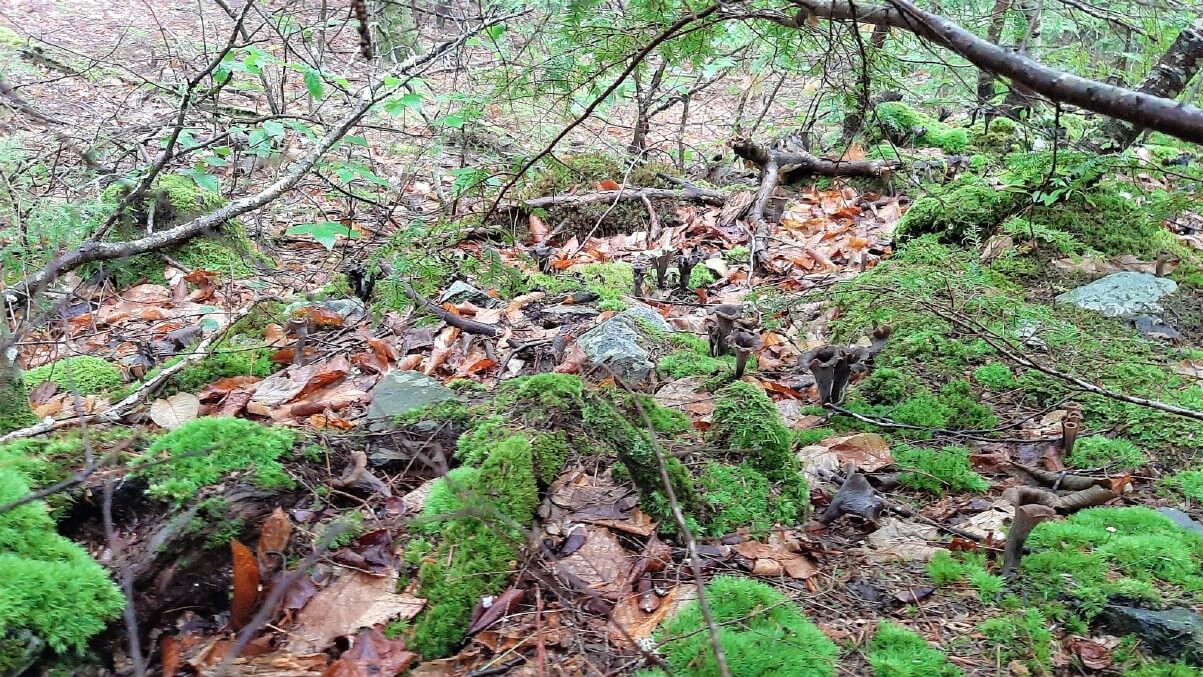
Common Mushrooms That Look Like Black Trumpets
There are no poisonous lookalikes for this unique edible mushroom, thank goodness. In fact, there aren't many mushrooms that can be confused with black trumpets. This makes them an excellent mushroom for beginner foragers.
These are the mushrooms that are most likely to be confused with black trumpets (but only for a moment until you inspect them closer).
Devil's Urn – At a glance, this mushroom looks a bit similar. However, further inspection will quickly inform you of the differences. The devil's urn mushroom is black and cup-shaped, not trumpet-shaped like the black trumpet. Also, this mushroom is a spring fungus, so you wouldn't be seeing it at the same time as black trumpet season.
Entoloma subcarneum – Again, an inspection will quickly tell you this is not a black trumpet, but it can be confused from a distance. This Entoloma species has a black cap that becomes indented in maturity. But, it also has gills, a proper stem, and a much more classic mushroom appearance.
Cooking With Black Trumpets
The taste and structure of black trumpets are delicate and should be treated with deference. Black trumpets are fragile, quick to break, and won't hold up to strenuous cooking techniques. Additionally, their smoky flavor is easily overpowered by stronger tastes, so it's best to use them as the dish's star. Don't drown black chanterelles in sauces or stews; you'll miss out on their brilliance. A simple sauté in butter with some fresh herbs is perfection. Black trumpets also are an excellent pizza addition, as long as there aren't other intensely flavored toppings.
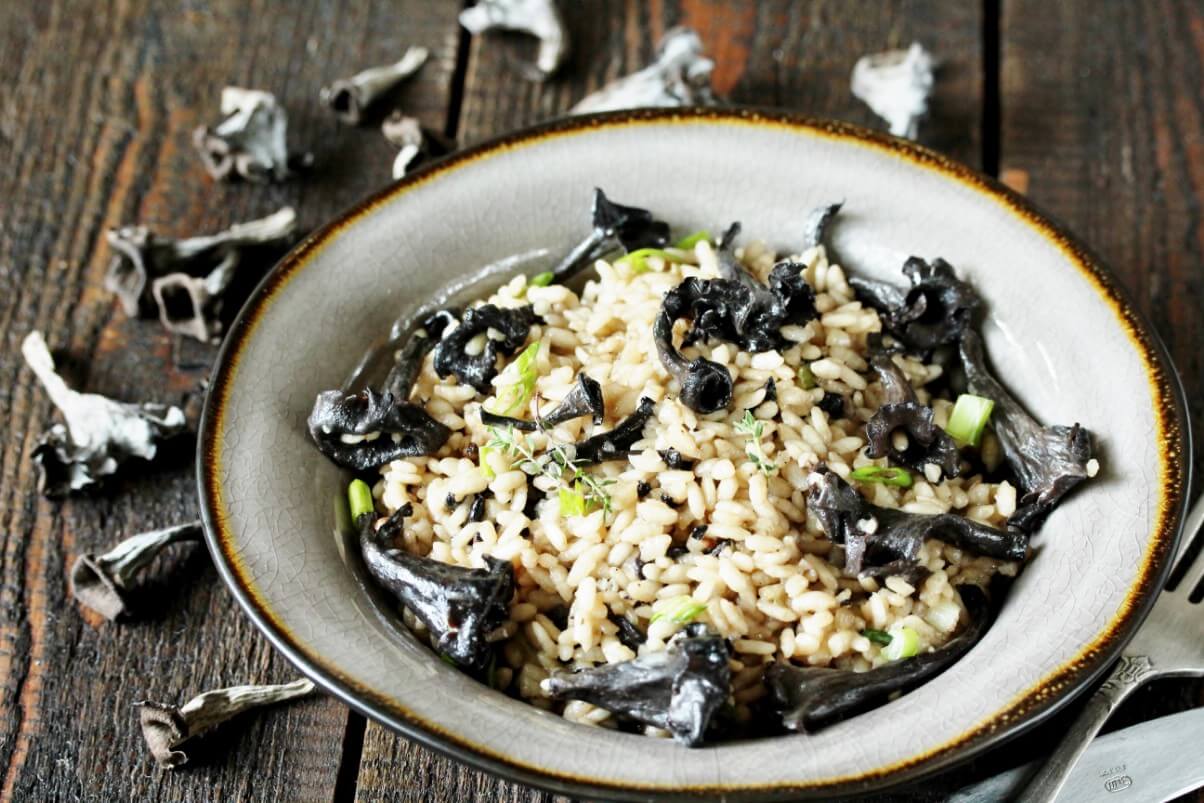
Black Trumpet Mushroom Recipes
Caramelized Black Trumpets and Shallots
Wild Black Trumpet Mushroom Spread
Black Trumpet Mushroom Puff Pastries
Wild Mushroom Soup with Black Trumpet Sauté
How To Store and Preserve Black Trumpet Mushrooms
Use fresh black trumpets within 3-4 days of foraging. The thin caps will deteriorate rather quickly, becoming slimy and entirely unpalatable. Store fresh black trumpets in a paper bag or wrapped in newspaper so they can breathe. Never store any type of mushroom in plastic; they won't be able to breathe and will decompose quickly.
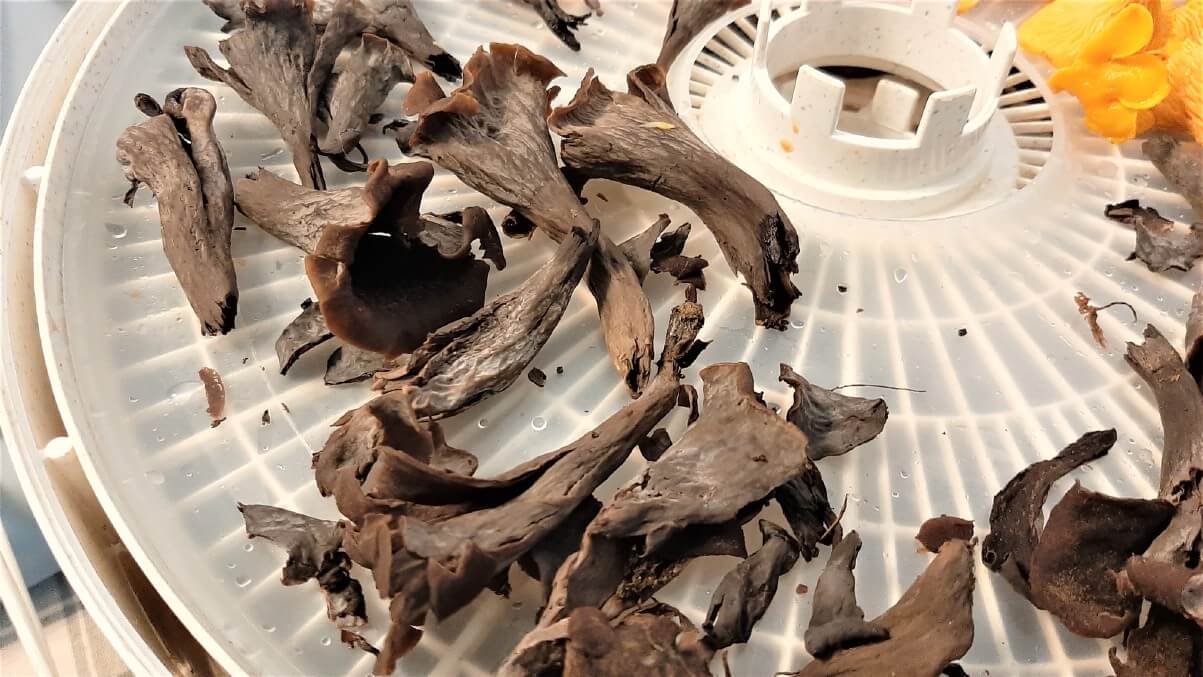
Black trumpets can be dried in a dehydrator or on low in the oven. Since they're so thin, they dry pretty quickly. Dried black trumpets can be stored as-is or turned into a powder to add to soups, stews, and risottos.

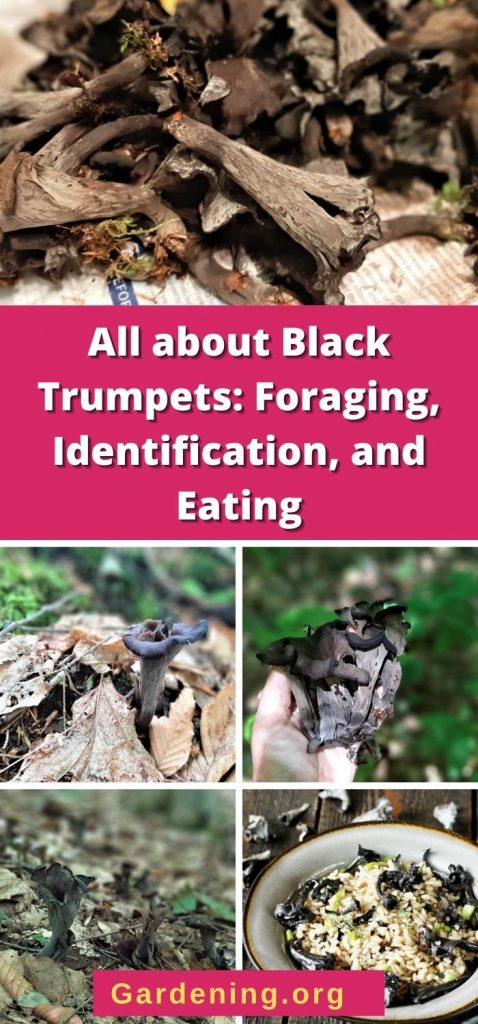
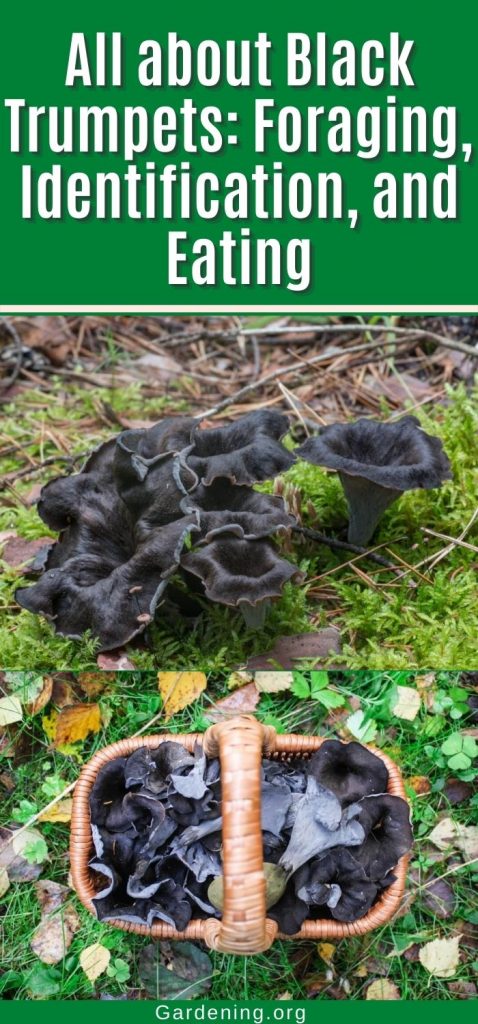
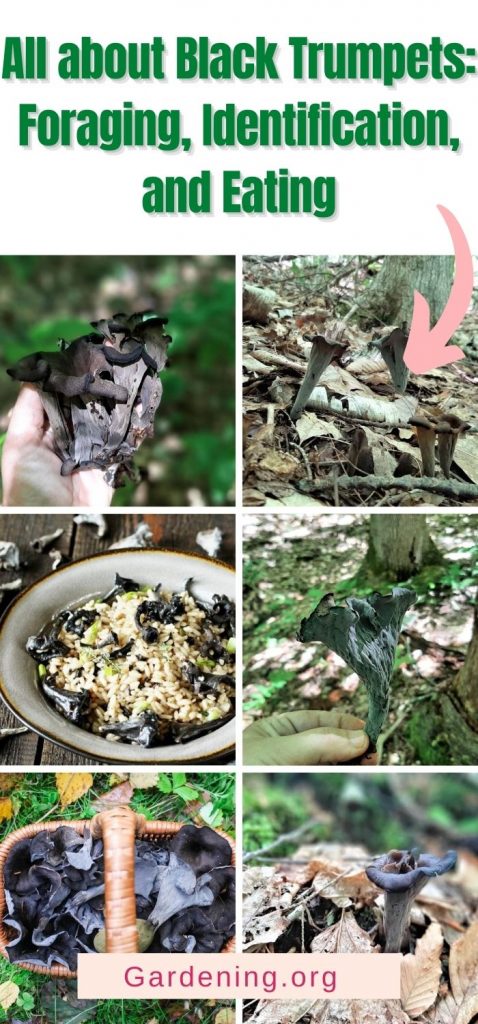

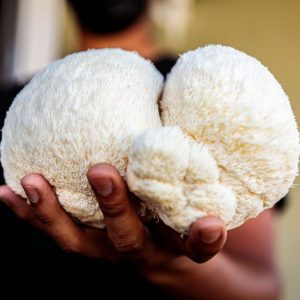
Charles Ford
I live in northern california and your habitat discription is so far off I can't believe it. first off the main type of tree that they grow around out here is the tan oak and very little around the trees mentioned. throw in some huckleberry bushes and some decaying wood and leaf matter and you have the perfect habitat for the west coast black trumpet. Out here in northern cali you can find trumpets on the shady sides of ridges and the sunny sides also. the ones growing on the southern facing slopes or the slopes that get sun light will be bigger and tend to be better mushrooms than the ones growing on the northern facing ridges or shady sides of hills. Northern facing ridge mushrooms tend to rot faster and mold easily. Southern facing mushrooms will dry out eventually. the size of the mushrooms will range from 1 to 6 inches on average but I have personally found some that have been over 12 inches long with some clumps of mushrooms being anywhere from 3 inches to 12 inches in diameter. They are a winter mushroom that generally starts in late December and goes into mid to late april. we occasionally start picking in mid to late November (depending on when the rains start) and go until the begining of June (again depending on the rains). So as you can see by what you just read your information on where, when, and size of the western US black trumpet is far from being correct. Sorry to point out your mistakes but it gets irritating to read about things in our own backyards that are so far from the truth that it makes you wonder how people can be so wrong about things they claim to be knowledgeable about . Any ways sorry for taking up so much of your time but I needed to set things straight
Jenny
Thank you for your detailed response on the black trumpets that grow in western North America. As mentioned at the beginning of the article, the western black trumpets (most likely a new species, possibly more than one) are not thoroughly defined yet.
Since my article wasn't specifically about the western species (it was, as mentioned also from the beginning, about Craterellus fallax, the eastern species), you'll have to forgive my west coast generalizations.
That's wonderful the black trumpet you encounter grows with tanoaks. However, just because you find them with tanoaks, that doesn't mean that's the only place they grow. The west coast is a lot more than just northern California, and there are many diverse habitats. Black trumpets also appear with conifers. Michael Kuo (mushroomexpert.com) lists conifers, Douglas fir, coast live oak, tanoak, and madrone as primary tree species. In my article, I do state that western species grow with hardwoods and conifers, and in the winter months.
Thank you for taking the time to write and reminding me I should do a post specifically about the west coast black trumpet, it's undefined taxonomy, and interesting growth habits.